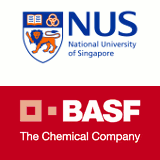The Graphene Research Centre (GRC) at the National University of Singapore (NUS) Faculty of Science and the world’s leading chemical company BASF have partnered to develop the use of graphene in organic electronic devices, such as organic light emitting diodes (OLED). The goal of this collaboration is to interface graphene films with organic electronic materials for the creation of more efficient and more flexible lighting devices.
 |
|
National University of Singapore (NUS) and chemical manufacturer BASF partner up to make graphene for OLED applications. (Photo Courtesy of NUS) |
“ Our motto at GRC is ‘Inventing the Future’ and the combination of graphene from GRC and organic materials from BASF is the perfect way to research possibilities that have not been explored before and can lead to transformative technology,” said Prof. Antonio Castro Neto, Director of the Graphene Research Centre and a Distinguished Professor at the Department of Physics, NUS Faculty of Science and Department of Electrical and Computer Engineering, NUS Faculty of Engineering. “ We are working towards a bright future where clean energy can be harvested, transported and stored in efficient ways, in order to be used to create a better and healthier living for all of us,”
“Graphene is a fascinating material, with regard to both its electronic properties and its mechanical strength. We have been engaged in the research of graphene for several years and are now ready to enter partnerships with excellence research centres in order to complement and speed up our device development,” said Dr Josef R. Wünsch, Senior Vice President Modeling & Formulation Research at BASF , also responsible for incubation in the graphene space.
The NUS team at GRC will be responsible for the synthesis and characterisation of the graphene. The researchers have already developed a patent-pending methodology for the reliable growth and transfer of high-quality graphene films onto different flexible substrates that can be used in solar cells and lighting panels. BASF develops and provides organic active materials that allow for its integration into a device, jointly with graphene films.
“Graphene is a potentially important component in the future of lighting and low-weight energy storage. Through this cooperation, we aim to greatly advance the performance of graphene-based next generation organic electronic devices,” said Dr Kitty Cha, a graphene research scientist at BASF who is managing the project.
The scientific aspects of the collaboration at NUS are coordinated by Prof. Loh Kian Ping, a leading chemist at GRC and Head of the Department of Chemistry at the NUS Faculty of Science. For the OLED project, the goal is to develop a robust process of transferring and incorporating graphene in OLED devices. The researchers have to overcome the key challenge of working with atomically thin films of graphene and interfacing these films efficiently with organic materials. If successful, incorporating graphene into OLED and other devices based on electronically active organic materials will allow for inexpensive, flexible and more efficient gadgets.
“Graphene, which is one of the crystalline forms of carbon, was only relatively recently discovered in 2004. The Graphene Research Centre at NUS Faculty of Science , which has already established itself as one of the leaders in the graphene research, is now also establishing itself as an industry collaborator, bringing about new applications of graphene across a wide range of sectors,” says Ms Irene Cheong, Director , NUS Industry Liaison Office , which facilitated this industry collaboration .












